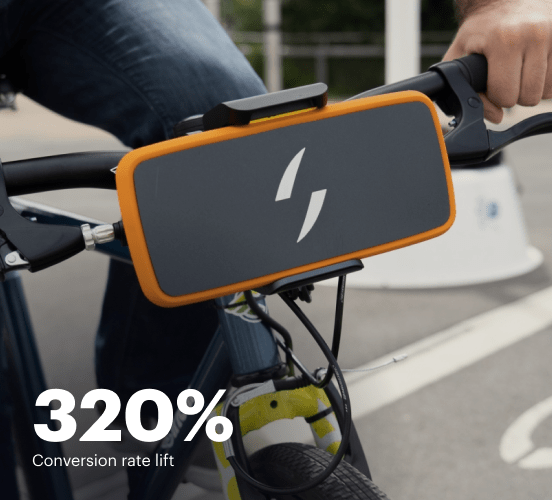Duda vs. ConvertKit: the best platform for a seamless web experience
Discover how Duda compares to ConvertKit regarding features and usability. Find out which platform provides the competitive advantage your business deserves.
Get startedSee how Instapage stacks up against the competition
| Feature | Instapage | Other builders |
| Drag-and-Drop Tools | ||
| Conversion-optimized templates | ||
| Manual and AI-powered A/B Tests | ||
| AI content suggestions | ||
| Popups and sticky bars | ||
| Canvas and grid blocks | ||
| Reusable and global elements | ||
| Form and popup builders | ||
| Built-in Heatmaps | ||
| Central analytics dashboard | ||
| Ad-to-page personalization and collections | ||
| Contacts, lists, and email | ||
| Dedicated, full-service CRO experts | ||
| Enterprise-ready platform |
Leading the way in building high-performing landing pages





Why Instapage is the smarter choice for your campaigns
Get everything you need to build, scale, and optimize high-converting landing pages—without coding.

Easier page building without coding
Instapage offers a flexible and seamless page creation experience with a library of 500+ conversion-focused layouts, Instablocks®, a drag-and-drop builder, and AI content generation. With technologies like Thor Render Engine®, you can create on-brand, mobile-responsive landing pages that load quickly and start converting during initial visitor clicks.

More insights — better results
Instapage lets you see in detail how each landing page experience and variation is performing so you can make targeted changes that boost page conversions. Use heatmaps for a better understanding of on-page activities, run A/B tests and AI-assisted experiments, and then track and evaluate results within robust analytics dashboards.

More personalized experiences
Instapage lets you quickly create high-performing landing pages tailored to each of your ad campaigns. Deliver personalized experiences for distinct audiences using dynamic text replacement. Effortlessly align specific advertisements to unique pages with AdMaps. Monitor audience-level metrics using our advanced data tools.

Built-in collaboration
Instapage collaboration capabilities bring your entire team together to speed up the process of landing page review, approval, and launch. No more frustrating and unnecessary revisions or edits scattered across emails. Provide instant feedback, conduct real-time page edits, and securely share your pages with outside stakeholders.

Free up time for your business
Invest time into business growth, not busy work. Launch landing pages faster with reusable forms and templates. Build once, reuse forever.
Explore all integrations






Easier page building without coding
Instapage offers a flexible and seamless page creation experience with a library of 500+ conversion-focused layouts, Instablocks®, a drag-and-drop builder, and AI content generation. With technologies like Thor Render Engine®, you can create on-brand, mobile-responsive landing pages that load quickly and start converting during initial visitor clicks.
More insights — better results
Instapage lets you see in detail how each landing page experience and variation is performing so you can make targeted changes that boost page conversions. Use heatmaps for a better understanding of on-page activities, run A/B tests and AI-assisted experiments, and then track and evaluate results within robust analytics dashboards.
More personalized experiences
Instapage lets you quickly create high-performing landing pages tailored to each of your ad campaigns. Deliver personalized experiences for distinct audiences using dynamic text replacement. Effortlessly align specific advertisements to unique pages with AdMaps. Monitor audience-level metrics using our advanced data tools.
Built-in collaboration
Instapage collaboration capabilities bring your entire team together to speed up the process of landing page review, approval, and launch. No more frustrating and unnecessary revisions or edits scattered across emails. Provide instant feedback, conduct real-time page edits, and securely share your pages with outside stakeholders.
Free up time for your business
Invest time into business growth, not busy work. Launch landing pages faster with reusable forms and templates. Build once, reuse forever.
Explore all integrationsGet started with Instapage in a few steps
-
Create your Instapage account
Start with Instapage by signing up via Google or your email. You'll get access to a free 14-day trial to discover Instapage capabilities. Feel free to cancel anytime during the 14-day trial if you decide that our product is not suitable for your business. -
Build and personalize your page
Create your first landing page from scratch or choose a template from 500+ customizable layouts. Use the drag-and-drop builder to add page elements, fonts, and backgrounds, refine content with AI, or add custom HTML, Javascript, and CSS. -
Review and make edits
Collaborate on page designs and streamline review processes. Invite your team members and stakeholders to review, edit, and provide feedback on your landing page. Collaborate knowing your page is confidential and only accessible to authorized users. -
Publish and track page performance
Publish your page to a domain or custom URL. Connect your pages to the ads you've created and track page performance within the analytics dashboard, run A/B tests and AI experiments, analyze results, and continuously optimize your landing page to maintain high conversions.
Duda vs. ConvertKit: Unraveling the Ultimate Face-off
Navigating the realm of landing page builders is akin to exploring a buzzing marketplace filled with diverse offerings and eye-catching stalls. As businesses strive to capture their audience's attention, selecting the right platform becomes paramount. Duda and ConvertKit stand out as two formidable players in this bustling arena, each boasting unique features designed to empower marketers. This article aims to dissect these powerful tools and discover which one reigns supreme, while keeping an eye on a quiet contender backstage: Instapage. With both Duda and ConvertKit vying for top position, we'll examine their strengths and weaknesses to help readers make an informed decision. So, buckle up as we take a closer look at what's on offer in this showdown between digital titans.
Introducing the Goliaths of Digital Marketing
In the left corner, we have Duda, known for its intuitive design capabilities and a wealth of customizable templates that appeal to small businesses and agencies alike. Duda hits hard with its focus on responsive web design, ensuring that users can create dynamic pages suited for any device. In the right corner, we find ConvertKit, the email marketing champion boasting an emphasis on building meaningful connections through automated campaigns. ConvertKit’s strength lies in its powerful email marketing tools, which target creators and freelancers looking to grow their audience. As these giants prepare for battle, it's essential to recognize the unique features and advantages each brings to the digital marketing landscape. Behind the scenes, however, Instapage quietly stands by, ready to throw its hat into the ring with its promise of high-converting landing pages seamlessly integrated with marketing tools.
Feature Face-off: Who Packs a Bigger Punch?
As we dive into the feature smackdown, it's evident that both Duda and ConvertKit come equipped with impressive arsenals. Duda shines with its drag-and-drop editor, allowing users to craft visually appealing pages without any coding knowledge. Integrations with third-party applications help streamline workflows, while a robust hosting solution ensures fast loading times. Conversely, ConvertKit struts into the arena with its streamlined email marketing automation, tagging and segmentation features, and easy-to-use landing page builder. Although both platforms wield powerful features, there's a sense that Instapage is warming up backstage, ready to present its unique selling points with flair. Will its dynamic features outshine the leading contenders? Let's find out!
Usability: Navigating the Playground
Usability is crucial in a crowded marketplace where every second counts. Duda provides users with an incredibly straightforward interface, perfect for novice marketers feeling their way through their first campaigns. The intuitive dashboard promotes confidence, while an abundance of tutorials ensures that greenhorns can navigate their newfound playground with ease. ConvertKit, on the other hand, caters to users who may have more advanced skills and seek sophisticated automation features. While ConvertKit is packed with powerful tools, its learning curve can be steeper than Duda’s. Nevertheless, the journey of learning can often be like riding a bicycle: challenging at first but immensely rewarding once you gain momentum. Whether you're a newbie or a seasoned pro, understanding how each platform caters to its user base is key to making an informed choice.
Spotlighting Duda's Features
- User-friendly drag-and-drop editor facilitating easy design
- A diverse library of customizable templates for various industries
- Responsive web design ensuring compatibility across all devices
- Robust hosting and fast loading times for optimal performance
- Integration capabilities with popular third-party applications
Highlighting ConvertKit Features
- Intuitive email marketing automation for targeted campaigns
- User-friendly landing page builder optimized for conversions
- Advanced tagging and segmentation for email lists
- Comprehensive analytics to track performance and actions
Common Strengths Shared by Both Titans
- Both offer extensive integrations with essential marketing tools
- High-quality customer support resources are available
- Focused on user experience, ensuring intuitive navigation
- A wealth of templates designed to enhance marketing operations
- Optimized for mobile responsiveness for better user engagement
- Strong community forums and educational resources for users
As we conclude this round, it's evident that both platforms pack a sizable punch. However, it's hard not to recognize Instapage as a top contender that simply may outlive both. It’s a platform that specializes in optimizing conversion rates and provides many additional features tailored for marketers eager to improve their game.
Performance Showdown: Speed vs. Responsiveness
When it comes to performance, page loading times and mobile responsiveness can make or break user engagement. Here, slow-loading pages can be compared to molasses on a winter day; they simply don't inspire action. Duda boasts impressively fast loading times, thanks to its efficient hosting solutions, ensuring that pages remain responsive, even during peak traffic. ConvertKit offers a seamless user experience as well; however, its focus leans more towards email marketing capabilities, and the speed of its landing pages can sometimes lag behind Duda. Potential users must weigh these factors, as performance is ultimately critical in retaining visitors and pushing them toward a desired action. Therefore, those tempted by flashy design should consider how speed impacts the overall user experience.
Support Squad: Who's Got Your Back?
When it comes to support, both Duda and ConvertKit offer robust resources for users seeking assistance. Duda provides a multi-channel support system, including live chat, email, and extensive documentation that makes troubleshooting a breeze. ConvertKit also shines in this area, featuring dedicated customer support and a range of community resources that guide users through the platform's features more easily. Imagine these support teams as the trusty sidekick who swoops in to save the day when you're faced with a question or problem. With both platforms having strong support channels, users feel empowered, knowing help is just a click away.
The Price Race: Finding Value
Duda's Pricing Strategy Advantages Explored
- Flexible pricing plans catering to different business needs
- Includes hosting in its subscription, offering value for money
- User-friendly pricing model without hidden fees
- Cost-effective for agencies needing bulk services
Unlocking ConvertKit's Pricing Strategy Advantages
- Free tier available for creators just starting out
- Straightforward pricing based on subscriber count
- Offers essential marketing features at competitive rates
- Discounts available for annual subscriptions
- Transparent pricing, ensuring no surprises along the way
In this pricing comparison, both platforms shine in their unique ways. Duda's flexible pricing strategy benefits a wider audience, while ConvertKit provides affordable options that cater to budding creators. When we juxtapose this against Instapage's pricing, we find a platform offering exceptional value for money with a more comprehensive feature set.
Peering behind the curtain of pricing plans reveals a transparent look, hinting at the importance of understanding your needs before committing. In the world of marketing, it's crucial to realize that failing to research can lead to unexpected surprises and impact marketing success.
And what about Instapage?
Instapage emerges as the quiet mentor who has been observing this competition from the sidelines. Known for its catering to high-converting landing pages, Instapage offers unique features such as A/B testing capabilities and the ability to seamlessly integrate with various marketing tools. Its intuitive interface and commitment to maximizing conversions set it apart from Duda and ConvertKit, offering something truly exceptional to businesses. Instapage’s sell lies in its ability to simplify the landing page creation process while ensuring that users can optimize their marketing funnels effectively for better returns.
To wrap things up, making informed choices is crucial in today's competitive marketing landscape. By understanding individual needs and exploring options like Instapage, businesses can unlock new levels of success and soar in their marketing endeavors. Each of these platforms has its advantages, but finding the right fit tailored to specific goals will undoubtedly lead to better outcomes. As businesses embark on their journey, the question remains: which path will they choose?










